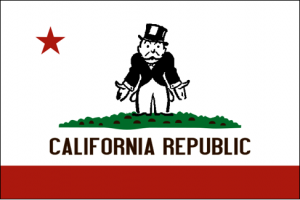
This might just be a new tax rate for some if Congress and President Obama don’t reach a deal before 2013.
On Nov. 6, Californians approved of Proposition 30, a massive tax hike on the state’s wealthiest residents. Now, the richest living in the Golden State making more than $1 million, face a new marginal state income tax rate of 13.3 percent — almost a 30 percent rate hike above their current rate.
This state tax coupled with an increasing federal tax, should Democrats in Congress and President Obama get their way, would mean the wealthiest in California would pay almost 52 percent of their income in taxes.
But don’t feel too sorry for the Golden State.
This is the same state where a “psychiatrist was paid $822,000, a highway patrol officer collected $484,000 in pay and pension benefits and 17 employees got checks of more than $200,000 for unused vacation and leave,” reports Bloomberg.
The article also highlights that “the state’s highest-paid employees make far more than comparable workers elsewhere in almost all job and wage categories, from public safety to health care, base pay to overtime.”
Do you think California taxpayers can afford this? No. But when confronted with the most powerful public employee unions in the nation, the state is choosing to tax its citizens at every opportunity. And just because you aren’t a California citizen doesn’t mean you shouldn’t pay attention. After all, the federal government is not just sitting back watching the Golden State spend and tax its way into oblivion. It is quietly lurking in the background and taking notes.
California is obviously in favor of higher tax rates on its “wealthy” as way to raise more revenue. President Obama and Democrats, and even some Republicans, are willing to do the same for everyone.
The Washington Post explains that if Congress and the president do not reach a deal before year’s end, taxes will go up for everyone. “Taxpayers making more than a $1 million will endure a $254,000 tax hike, on average, or about 11 percent of their income. Those making $40,000 to $50,000 will see a $1,700 tax jump, or about 4.4 percent of their income.”
The article goes on to state that the average American would see tax bills rise by $3,446 next year.
But why limit the federal government to raising just the federal income tax? It is very likely they have a keen eye on California’s new cap-and-trade program as well—and thinking of expanding it to a national level.
California’s recent cap-and-trade program stems from the state’s 2006 global warming regulations attempting to reduce emissions of greenhouse gases. Businesses in the state are now required to cut emissions to desired levels or buy pollution allowances from other companies. Many California industries, including petroleum refiners, have been outspoken opponents of this program.
The Sacramento Bee explains, “Many affected businesses call it a cleverly disguised tax that will cost them upwards of $1 billion in the first year. The expense will balloon in 2015, when refineries will have to buy more credits to cover greenhouse gases spewed by cars and trucks.”
Its first cap-and-trade auction was held Nov. 14. The California Air Resources Board said 23.1 million permits, which allow for one ton carbon, sold for $10.09 each at the auction.
Just how serious is the federal government about starting this kind of program?
Groups like the American Enterprise Institute (AEI), the Brookings Institution, the International Monetary Fund (IMF) and Resources for the Future think this kind of program on a federal level is not far off.
The Daily Caller reports that these groups hosted an event last month to discuss the economics of a carbon tax and had an Obama Treasury Department official as the keynote speaker.
The Brookings Institution reports “a carbon tax starting at $20 per ton and rising at 4 percent annually per year in real terms would raise on average $150 billion a year over a 10-year period while reducing carbon dioxide emissions 14 percent below 2006 levels by 2020 and 20 percent below 2006 levels by 2050.”
Sounds like similar justification for why California started the program within its borders. Though it is too early to see any results of the cap-and-trade program in the Golden State, there are definite red flags that the federal government should note before making the program a nationwide endeavor.
An Institute for Energy Research (IER) study, by Robert P. Murphy, indicates “The dismal record of the U.S. government in implementing efficient climate change policies is hardly evidence in favor of a massive new carbon tax (or cap-and-trade program). On the contrary, it is evidence that such a new program will be abused in the political process, and will not be tailored to the recommendations of climate scientists and environmental economists.”
While California businesses and taxpayers cope with this clever cap-and-trade tax as well as higher taxes for its greatest earners, others can look to this guinea pig of a state thankful they do not live or do business in its broke, heavily regulated and taxed climate—for now.
But with trillion-dollar deficits continuing to face the nation for as far as the eye can see, the calm before the storm might soon be over as elected politicians look on new ways to tax its people. And if California is the golden example, then this nation has lot to worry about.
Rebekah Rast is a contributing editor to Americans for Limited Government (ALG) and NetRightDaily.com. You can follow her on twitter at @RebekahRast.






